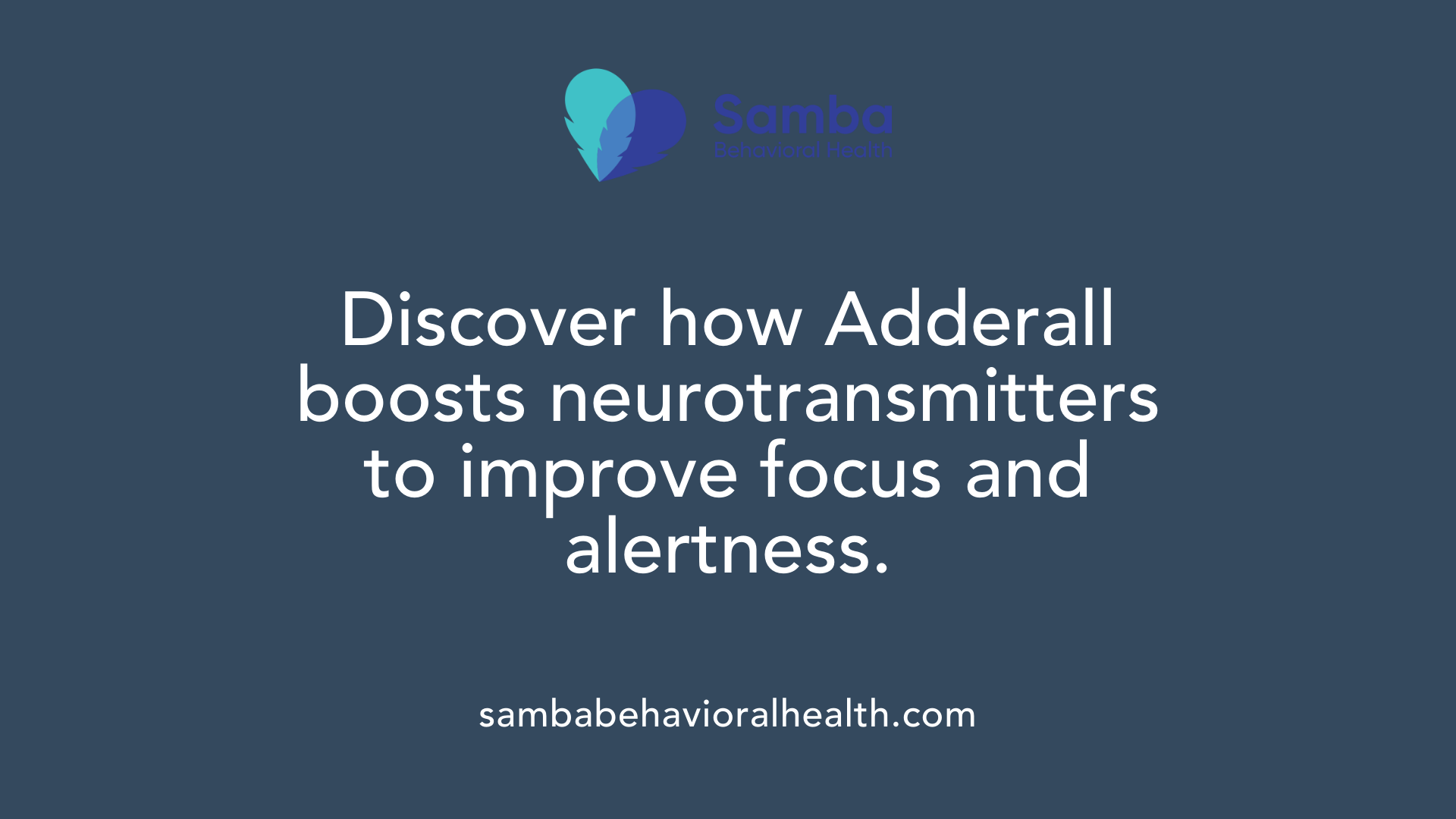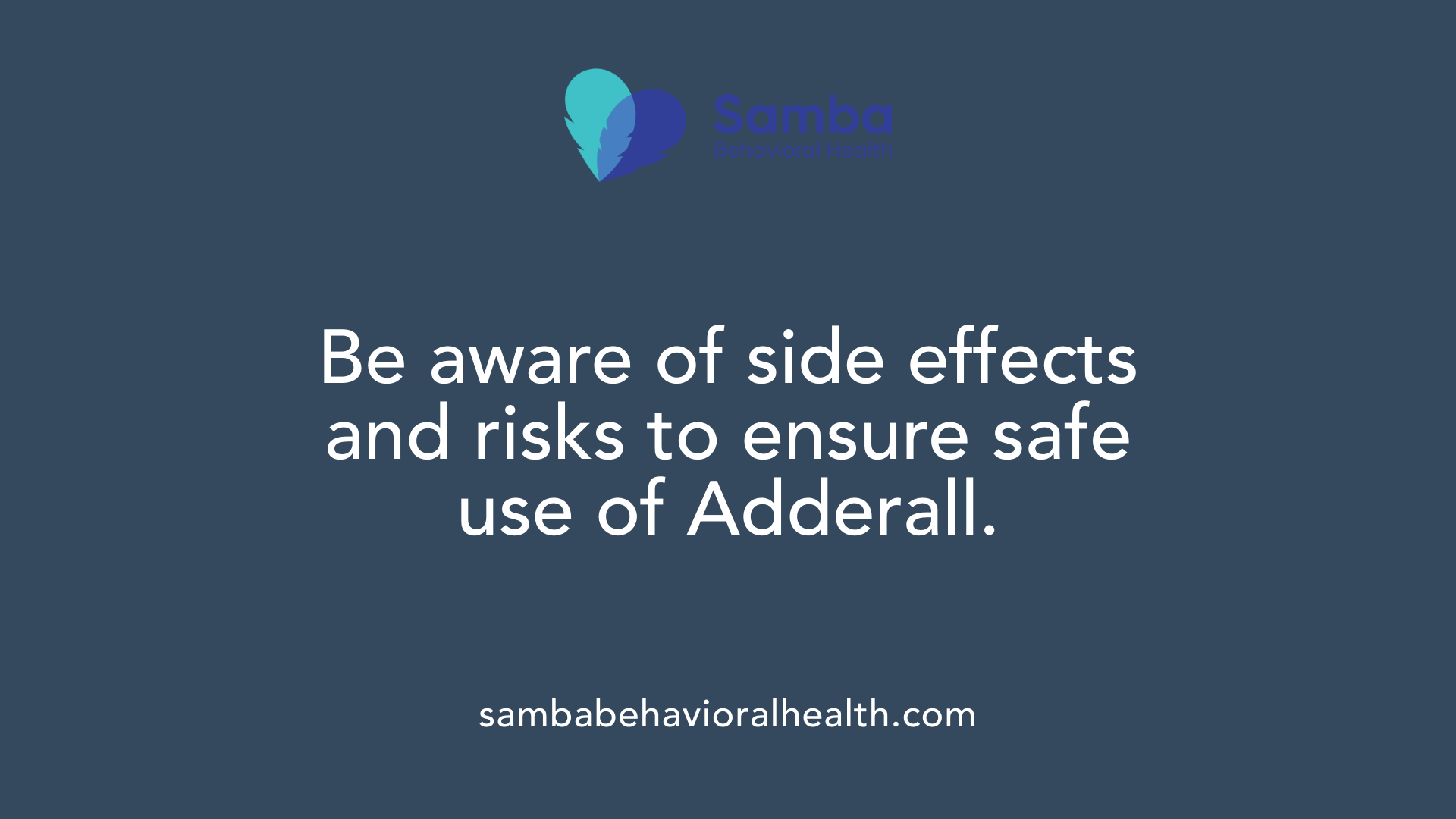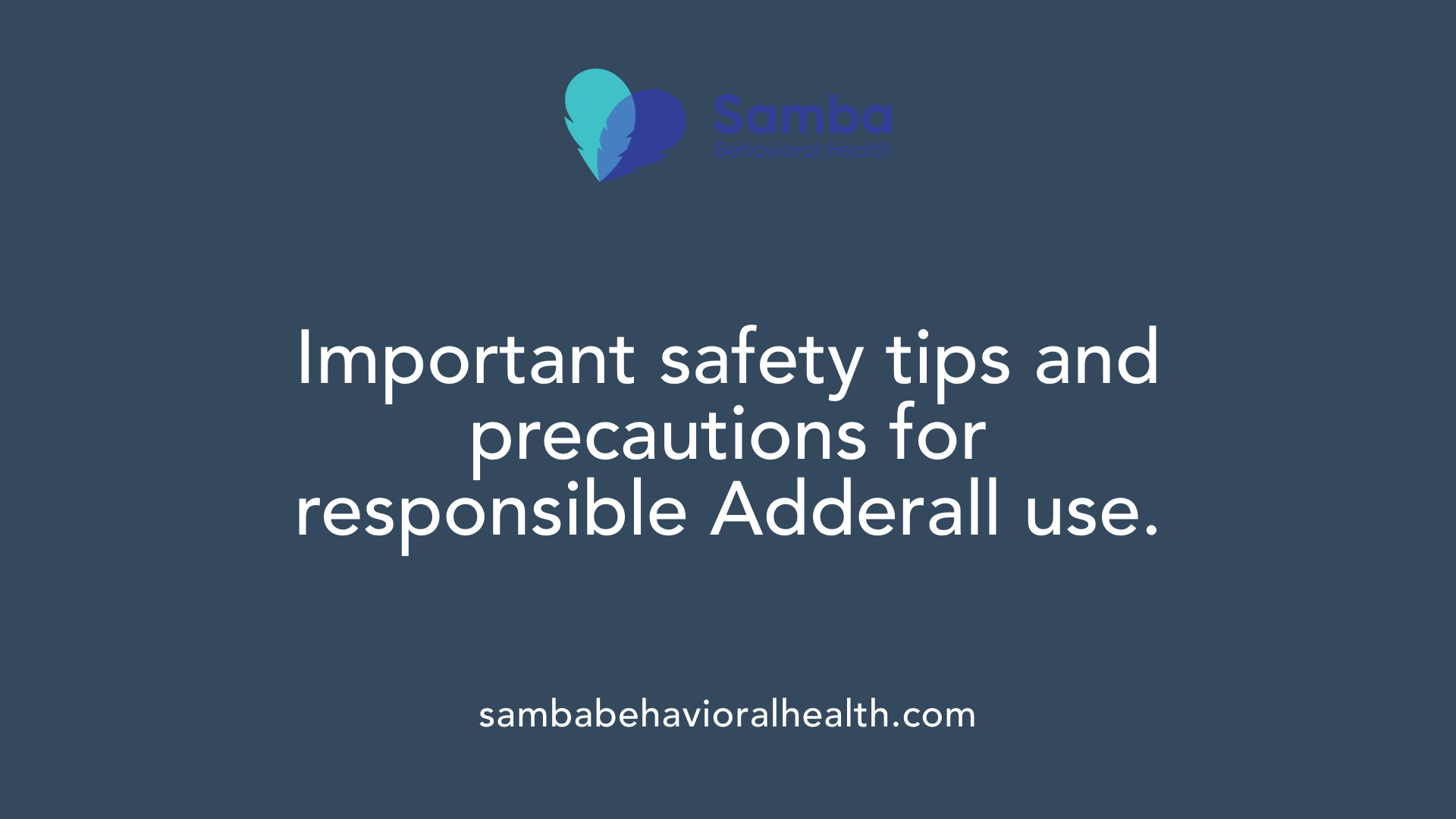Understanding Adderall: A Comprehensive Overview
Adderall is a widely prescribed medication primarily used to manage conditions like Attention Deficit Hyperactivity Disorder (ADHD) and narcolepsy. Its effectiveness in improving focus and alertness is well established, but its potential for misuse and significant health risks necessitate a clear understanding of what the drug is, how it works, and the precautions associated with its use.
What Is Adderall and How Does It Work in the Body and Brain?

What is Adderall and how does it work in the body and brain?
Adderall is a prescription stimulant medication mainly used to treat Attention Deficit Hyperactivity Disorder (ADHD) and narcolepsy. It contains a combination of amphetamine salts, specifically dextroamphetamine and levoamphetamine, which are central nervous system stimulants.
The primary way Adderall works is by increasing the levels of two key neurotransmitters in the brain: dopamine and norepinephrine. These chemicals are involved in regulating attention, alertness, and impulse control. By boosting these neurotransmitters, Adderall helps improve focus, reduce hyperactivity, and minimize impulsivity in individuals with ADHD.
On a biochemical level, Adderall blocks the reuptake of dopamine and norepinephrine into nerve cells and promotes their release. This results in higher concentrations of these chemicals in the synaptic cleft, enhancing transmission between nerve cells. The increased activity of dopamine and norepinephrine in areas of the brain responsible for attention and arousal underpins the medication’s benefits.
While Adderall has therapeutic benefits for those with ADHD, it can have stimulating effects in people without the condition. In non-ADHD users, it can cause feelings of euphoria, heightened energy, and increased alertness. However, this does not mean it improves cognitive abilities, and misuse can lead to serious health risks.
Effects of Adderall are typically observed within 30 minutes to an hour after ingestion, with peak plasma levels occurring around 3 hours. The duration of action depends on the formulation—short-acting versions last about 4 to 6 hours, while extended-release forms (like Adderall XR) can last up to 12 hours.
Because of its potent effects and potential for abuse, Adderall is classified as a Schedule II controlled substance. When taken as prescribed and under strict medical supervision, it can be effective in managing ADHD symptoms. However, misuse or long-term use carries risks such as dependence, cardiovascular problems, and mental health issues, emphasizing the importance of careful medical oversight.
Medical Uses and Indications of Adderall

What are the medical uses and indications of Adderall?
Adderall is most commonly prescribed to treat two main conditions: attention deficit hyperactivity disorder (ADHD) and narcolepsy. In individuals with ADHD, Adderall helps increase focus, attention, and impulse control by balancing certain chemicals in the brain, particularly norepinephrine and dopamine. This medication can significantly reduce symptoms of hyperactivity and improve overall functioning.
For patients with narcolepsy, a sleep disorder characterized by sudden sleep attacks and excessive daytime sleepiness, Adderall acts as a stimulant to promote wakefulness and alertness, helping them stay awake during the day.
Adderall is available in different formulations, primarily as immediate-release tablets and extended-release capsules (known as Adderall XR). The immediate-release form typically lasts about 4 to 6 hours, making it suitable for short-term symptom management, while the extended-release version can last up to 12 hours or longer, providing longer-lasting control of symptoms.
It is prescribed for children starting at age 3 and for adults of all ages, including those with ADHD and narcolepsy. In children, especially, the medication has shown to improve symptoms in approximately 80% of cases, making it highly effective.
Despite its effectiveness, Adderall is a controlled substance due to its potential for misuse, dependence, and serious side effects, including heart issues, mental health disturbances, and growth suppression in children. Because of these risks, it must be used strictly under medical supervision, with careful dosing and monitoring by healthcare professionals.
Potential Side Effects and Health Risks of Adderall

What are the potential side effects and health risks associated with Adderall?
Adderall, a stimulant medication primarily used to treat ADHD and narcolepsy, carries a variety of potential side effects and health risks. While many users tolerate the medication well when taken as prescribed, some may experience adverse effects that require medical attention.
Common side effects include decreased appetite, trouble sleeping, dry mouth, headaches, dizziness, nausea, and mood swings. These effects are often manageable but can impact daily well-being. In children, Adderall may also cause growth suppression if used long-term.
More serious health issues involve the cardiovascular system. Users might experience increased blood pressure, rapid heartbeat, or circulation problems. These signs warrant immediate medical evaluation, especially for those with pre-existing heart conditions.
Behavioral and mental health risks are notable. Adderall can induce hallucinations, psychosis, or aggressive behavior in some cases. It can also lead to the development of tics and, rarely, serotonin syndrome—a potentially life-threatening condition caused by excessive serotonin levels. Allergic reactions, although uncommon, include skin rashes, swelling, or difficulty breathing.
The medication may affect children’s growth patterns and developmental milestones if not carefully monitored. It can also trigger mental health disturbances such as hallucinations, paranoia, or manic episodes.
Physically, Adderall may lead to symptoms like increased blood pressure and circulation issues, highlighting the importance of regular monitoring by healthcare providers. Long-term misuse increases the risks of dependency, heart problems, and mental health complications, reinforcing that Adderall should always be used under strict medical guidance.
In summary, while effective for many individuals, Adderall's potential risks make it essential that the medication be used responsibly, with close medical supervision to mitigate adverse effects and ensure patient safety.
Safety Considerations and Precautions during Use

How safe is Adderall, and what precautions should be taken during its use?
Adderall can be effective and safe when used exactly as prescribed by a healthcare provider. However, because it is a stimulant with a potential for abuse and dependence, careful medical supervision is crucial. Serious health risks include heart problems such as increased blood pressure and heart rate, as well as mental health issues like hallucinations, psychosis, and anxiety. Its use can lead to dangerous outcomes such as stroke or even sudden death, particularly in individuals with pre-existing cardiovascular conditions.
To ensure safety, screening for health conditions like heart disease, high blood pressure, and mental health Disorders should be performed before starting the medication. Regular monitoring for adverse effects such as changes in heartbeat, mood, or appetite helps in adjusting the dosage or discontinuing if necessary.
It is vital to follow the prescribed dosage strictly. Misusing or taking high doses increases the risk of severe side effects, overdose, or dependency. Overdose symptoms may include restlessness, hallucinations, panic, muscle pain, dark urine, seizures, or coma. Immediate medical attention is necessary if overdose is suspected.
Avoiding alcohol and contraindicated medications is essential. Alcohol can amplify adverse effects or interact dangerously with Adderall, potentially leading to heart issues or overdose. Certain medications may also interact negatively, so informing your doctor about all medicines you are taking is important.
Proper storage prevents unauthorized use and accidental ingestion. Keep Adderall at room temperature, in a secure, light-protected place, out of reach of children or others who should not have access.
In summary, Adderall's safety depends on appropriate medical oversight, adherence to prescribed use, and awareness of potential risks. Following these precautions can help maximize benefits while minimizing health risks.
Long-Term Effects and Impact of Adderall
Adderall, when used over extended periods, can have significant effects on various aspects of health. One major concern is potential neurotoxicity; high doses or misuses may damage dopaminergic neurons in the brain, leading to cognitive deficits or mood disturbances.
In children and adolescents, prolonged stimulant treatment has been associated with slowed growth in height and weight. However, some children experience recovery of growth once the medication is gradually discontinued or dosage adjusted. Despite these possibilities, ongoing growth suppression remains a concern that requires regular monitoring.
Dependence and tolerance are also notable risks associated with long-term Adderall use. Patients may develop a psychological reliance on the medication, and over time, higher doses might be needed to achieve the same effects. This escalation increases the potential for adverse health outcomes.
Cardiovascular risks expand with continued use, including elevated blood pressure, irregular heart rhythms, and, in some cases, increased risk of serious events like stroke or heart attack. These risks are heightened in individuals with preexisting heart conditions.
Additionally, some users may experience mental health effects such as the development of psychosis, depression, or mood swings, especially following misuse or in the absence of medical supervision. Such effects highlight the importance of ongoing medical oversight.
Overall, while Adderall can be effective for managing ADHD and narcolepsy when prescribed appropriately, its long-term impact underscores the necessity for careful medical supervision, dose management, and regular health assessments to mitigate potential risks.
Addiction, Misuse, and Withdrawal Risks of Adderall
Is Adderall addictive, and what are the risks of misuse and withdrawal?
Adderall is a prescription medication that can be highly addictive due to its stimulant properties. It contains amphetamine and dextroamphetamine, which increase dopamine and norepinephrine levels in the brain. These chemicals are associated with feelings of alertness, energy, and euphoria.
Because of these effects, Adderall has a significant potential for abuse and dependence, especially when taken in doses higher than prescribed or through non-medical routes like snorting or injecting. Misusing Adderall can quickly lead to tolerance, where larger doses are needed to achieve the same effect, and this can foster compulsive use.
The risks of misuse include serious health issues such as heart problems, mental health disturbances like anxiety, paranoia, and psychosis, as well as overdose. Overdose symptoms can involve rapid heartbeat, hallucinations, panic attacks, muscle pain, dark urine indicating possible liver or kidney stress, seizures, or even coma.
Withdrawal symptoms are a major concern when stopping Adderall. These may include fatigue, increased cravings, depression, mood swings, irritability, and physical symptoms such as body aches or tremors. The challenging nature of withdrawal often requires medical support and a supervised cessation plan.
Overall, although Adderall is effective for ADHD and narcolepsy when used properly, its high potential for addiction and the associated health risks underline the importance of using it strictly under medical supervision.
Differences Between Adderall and Related Medications

What is the difference between Adderall and other stimulant medications like Ritalin?
Adderall and Ritalin are commonly prescribed stimulant medications for ADHD and narcolepsy, but they differ significantly in their chemical makeup and how they work in the brain. Adderall is a combination of amphetamine salts, specifically dextroamphetamine and levoamphetamine, which increase the levels of neurotransmitters such as dopamine, norepinephrine, and serotonin. These chemicals help improve focus, alertness, and impulse control.
In contrast, Ritalin contains methylphenidate, a different type of stimulant. It primarily acts by blocking the reuptake of dopamine and norepinephrine, which increases their availability in the brain but through a different biochemical pathway. This leads to improved attention but may affect the brain's reward and motivation systems differently.
The differences in chemical composition impact how quickly each medication works, how long their effects last, and their side effect profiles. For example, Adderall often lasts longer, with its effects extending about 4 to 6 hours for immediate-release and up to 12 hours for extended-release formulations.
How do the chemical composition and mechanism of action differ?
Adderall’s active ingredients are salts of amphetamine, which increase the release and block the reuptake of dopamine, norepinephrine, and serotonin, stimulating the central nervous system. This broad spectrum of action can produce more intense stimulant effects.
Meanwhile, methylphenidate (Ritalin) mainly inhibits the reuptake of dopamine and norepinephrine, leading to increased concentrations in the synaptic cleft. Although both mechanisms enhance alertness and concentration, the different pathways can result in variations in onset time and side effects.
Duration of effects and potency
Adderall's immediate-release form typically lasts around 4 to 6 hours, with extended-release options lasting up to 12 hours. In comparison, Ritalin's long-acting formulations last about 6 to 12 hours, depending on the specific product.
Vyvans, another stimulant used for ADHD, has a different profile. As a prodrug of dextroamphetamine, Vyvanse is metabolized slowly, leading to a gradual increase in active drug levels, which can reduce the potential for misuse and side effects.
Potential for abuse and side effect profiles
Both Adderall and Ritalin are Schedule II controlled substances, indicating high potential for abuse and dependence. However, Adderall's potent effects on multiple neurotransmitters can make it more likely to produce side effects like increased heart rate, blood pressure, and potential for psychological dependence.
Side effects common to both include decreased appetite, trouble sleeping, dry mouth, and mood swings. Serious risks such as heart problems, psychosis, and circulation issues can occur, especially with misuse or long-term use.
Advantages of prodrug formulations like Vyvanse
Vyvanse, being a prodrug of dextroamphetamine, is designed to be metabolized slowly in the body. This can lead to fewer peaks and troughs in blood levels, reducing the likelihood of side effects and abuse potential.
It offers a longer duration of action—up to 14 hours—making it convenient for all-day symptom control. Its slow activation can also result in milder side effects and a lower risk of sudden misuse.
| Medication | Composition | Duration of Action | Abuse Potential | Notable Advantages |
|---|---|---|---|---|
| Adderall (immediate-release) | Mixed salts of amphetamine | 4-6 hours | High | Rapid effect, flexible dosing |
| Adderall XR | Extended-release | Up to 12 hours | High | Once or twice daily dosing |
| Vyvanse | Lisdexamfetamine, a prodrug | About 10-14 hours | Lower | Longer acting, milder side effects |
| Ritalin (long-acting) | Methylphenidate available in extended form | 6-12 hours | High | Different mechanism, shorter onset |
By understanding these differences, healthcare providers and patients can make informed choices tailored to individual needs and lifestyles.
Legal Status, Prescription Requirements, and Accessibility
Can a person obtain a prescription for Adderall, and what are the legal requirements?
Yes, a person can obtain a prescription for Adderall, but only through a legitimate healthcare provider following strict legal procedures. To qualify, individuals must undergo a thorough assessment by a licensed medical professional, such as a psychiatrist, neurologist, or qualified nurse practitioner.
The process begins with a comprehensive evaluation that often includes detailed clinical interviews, behavioral assessments, and review of medical history. Since ADHD is diagnosed based on specific criteria outlined in clinical guidelines, there is no single test for diagnosis. The healthcare provider will determine whether the symptoms warrant medication like Adderall.
Traditionally, prescriptions are given after an in-person consultation. However, during the COVID-19 pandemic, telehealth services have become more common. Many regions now allow remote evaluations, as long as the provider is registered and authorized to prescribe controlled substances.
Legal rules require providers to be registered with the Drug Enforcement Administration (DEA) and to adhere to national and state regulations governing prescription practices. This includes checking Prescription Monitoring Programs (PMPs) to prevent misuse and overprescription.
It is illegal to self-prescribe or obtain Adderall without a licensed healthcare professional’s evaluation. Unregulated use poses serious health risks and can lead to legal repercussions, including fines and criminal charges.
| Aspect | Requirement | Details |
|---|---|---|
| Prescription legality | Must be prescribed by an authorized healthcare professional | Prescriber must be registered with DEA, licensed, and follow regulations |
| Diagnostic process | Thorough evaluation by licensed professional | Includes clinical interviews, behavioral assessments, and medical history review |
| Telehealth options | Allowed in many regions | Must meet local telehealth prescribing laws |
| Monitoring | Prescription monitoring programs required | To ensure appropriate use and prevent abuse |
| Illegal procurement | Not permitted | Self-prescribing or acquiring from unregulated sources carries legal and health risks |
Understanding and complying with these regulations are essential for safe, legal access to Adderall. Responsible prescribing and usage help prevent misuse and safeguard both individual and public health.
Balancing Benefits and Risks of Adderall Use
Adderall remains an effective and widely used medication for managing ADHD and narcolepsy, significantly improving quality of life for many patients. However, due to its high potential for dependence, serious side effects, and legal restrictions, it must be used strictly under medical supervision. Awareness of its effects, proper monitoring, and adherence to prescribed guidelines are essential to maximize benefits while minimizing risks. Ongoing research continues to shed light on its long-term impacts, guiding safer usage and alternative treatments for those who require them.
References
- Adderall: Uses, Dosage, Side Effects & Safety Info - Drugs.com
- Amphetamine/Dextroamphetamine (Adderall, Mydayis, and others)
- [PDF] ADDERALL (CII) - accessdata.fda.gov
- Adderall Effects, Risks, and Dangers: Short and Long Term
- 6 Things to Know About Adderall | Top Trends | Healthy News Blog
- Dextroamphetamine and Amphetamine: MedlinePlus Drug Information
- Amphetamine (Adderall) | National Alliance on Mental Illness (NAMI)
- Adderall: Side effects, dosage, with alcohol, and more
- How Adderall Affects the Brain - Caron Treatment Centers
- Dextroamphetamine-Amphetamine (Adderall®) - MotherToBaby
